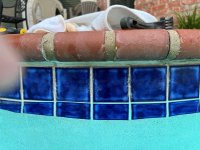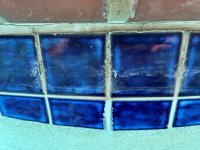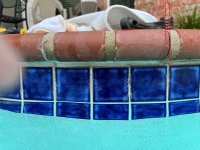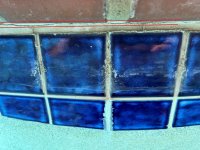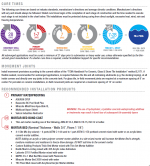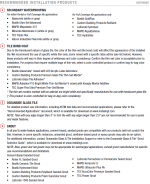I have a problem with the tile grout at the waterline. I'll describe what I'm seeing (with pictures!), what I did, and then the recent history.
As illustrated in picture 1, there is some kind of build up on the grout that is above the waterline, but not below the waterline (with one exception to be described in a moment). I thought this might be precipitated salts (e.g, calcium chloride) that also spread onto the adjacent tile. I was puzzled that the deposits were above the waterline. I tried to remove with a stainless steel brush (visible in the picture) with little effect. Then I gently scraped with a flat blade screwdriver and it came off the tile as well as the grout. But some grout lines were very soft or had air pockets and a comprised joint was left as seen in the center joint. The build up appears worse on the convex surfaces (as seen here) than on the flat surfaces.
There is a unique joint shown in picture 2 that is one of the nastier above-waterline joints but with what appears to be a different kind of deposit below the waterline that extends slightly onto the plaster (Diamond-Brite).
So here's the history: Pool was resurfaced 27 months ago by some yahoo impersonating a pool expert. (I have a litany of issues with how the job was done but do not interpret my statement as bitterness. I have been through all the stages and have emerged a more understanding, tolerant, and benevolent human being.) Following resurface, the pH kept shooting up to 8.2 for months (iirc) and we kept adjusting pH and TA. (I don't know if my logs go back that far.) CH has been 250-275 but I refrained from adjusting that as our local is fairly hard and I thought it would increase over time (as water evaporated and the auto-fill added water). I noticed the grout problem 2-3 months ago and becoming concerned that low CH might be leaching calcium, I bought CaCl2 and gradually added 15 lbs over the past month to raise CH to 425 (assuming I can do the test properly). pH has been fairly stable: drifts up to 7.8 and a little acid drops it to 7.5. TA has generally been 70-80 and CYA 45-55 but recently bumped to 60 (which I'm ok with because I think the Texas sun has been burning up the chlorine).
I've done some research on the forum and suspect it may be efflorescence. Never heard of it before and I'm not a chemist (although I passed college chemistry). So I'm looking for a confirmation or a proper diagnosis then a prescription on what to do. (I hear you - don't scrape it with a screwdriver.) And how to repair the grout, hopefully myself. Hopefully in just a few spots but I'm concerned the efflorescence has caused too much grout deterioration.
The forum has been very helpful. I am sincerely grateful for those who take the time to share their expertise.
Lloyd
As illustrated in picture 1, there is some kind of build up on the grout that is above the waterline, but not below the waterline (with one exception to be described in a moment). I thought this might be precipitated salts (e.g, calcium chloride) that also spread onto the adjacent tile. I was puzzled that the deposits were above the waterline. I tried to remove with a stainless steel brush (visible in the picture) with little effect. Then I gently scraped with a flat blade screwdriver and it came off the tile as well as the grout. But some grout lines were very soft or had air pockets and a comprised joint was left as seen in the center joint. The build up appears worse on the convex surfaces (as seen here) than on the flat surfaces.
There is a unique joint shown in picture 2 that is one of the nastier above-waterline joints but with what appears to be a different kind of deposit below the waterline that extends slightly onto the plaster (Diamond-Brite).
So here's the history: Pool was resurfaced 27 months ago by some yahoo impersonating a pool expert. (I have a litany of issues with how the job was done but do not interpret my statement as bitterness. I have been through all the stages and have emerged a more understanding, tolerant, and benevolent human being.) Following resurface, the pH kept shooting up to 8.2 for months (iirc) and we kept adjusting pH and TA. (I don't know if my logs go back that far.) CH has been 250-275 but I refrained from adjusting that as our local is fairly hard and I thought it would increase over time (as water evaporated and the auto-fill added water). I noticed the grout problem 2-3 months ago and becoming concerned that low CH might be leaching calcium, I bought CaCl2 and gradually added 15 lbs over the past month to raise CH to 425 (assuming I can do the test properly). pH has been fairly stable: drifts up to 7.8 and a little acid drops it to 7.5. TA has generally been 70-80 and CYA 45-55 but recently bumped to 60 (which I'm ok with because I think the Texas sun has been burning up the chlorine).
I've done some research on the forum and suspect it may be efflorescence. Never heard of it before and I'm not a chemist (although I passed college chemistry). So I'm looking for a confirmation or a proper diagnosis then a prescription on what to do. (I hear you - don't scrape it with a screwdriver.) And how to repair the grout, hopefully myself. Hopefully in just a few spots but I'm concerned the efflorescence has caused too much grout deterioration.
The forum has been very helpful. I am sincerely grateful for those who take the time to share their expertise.
Lloyd


